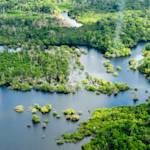World's largest restoration project, Africa's Great Green Wall
2007 CE • West Africa
"Launched in 2007 by the African Union, the Great Green Wall is a concerted attempt to slow and even reverse the spread of the world’s largest hot desert. Supported by the UNCCD, more than 20 countries across the Sahel are now planting trees to create what they claim will be the world’s largest living “structure”. In Burkina Faso, Mali and Senegal, for example, farmers have been rehabilitating land by using zai, a traditional practice of building lines, stripes and semi-circles of stones that help to retain water during dry periods and allow it to soak into the hard soil. In other parts of Ghana, villagers have been planting elephant grass as a way of holding the soil together, while also using it to weave baskets . . . But at the centre of the project are trees. Senegal alone has planted more than 12 million drought-resistant trees in just over a decade since the Great Green Wall was launched. “About 30 million hectares (300,000sq km) of degraded land has been restored across 20 countries,” says Thiaw. “But we are only at the beginning of a long journey . . . The UNCCD has set the target of restoring 100 million hectares (1 million sq km) of land in Africa by 2030."
Richard Gray, “The Wall Holding Back a Desert,” BBC, September 3, 2019.
Image: TREEAID via Flickr, Attribution 2.0 Generic (CC BY 2.0)


Learn about Maya Lin’s fifth and final memorial: a multi-platform science based artwork that presents an ecological history of our world - past, present, and future.

Discover ecological histories and stories of former abundance, loss, and recovery on the map of memory.

Learn how we can reduce our emissions and protect and restore species and habitats – around the world.

See how art can help us rethink the problems we face, and give us hope that each one of us can make a difference.

Help make a global memorial something personal and close to home. Share your stories of the natural world.


